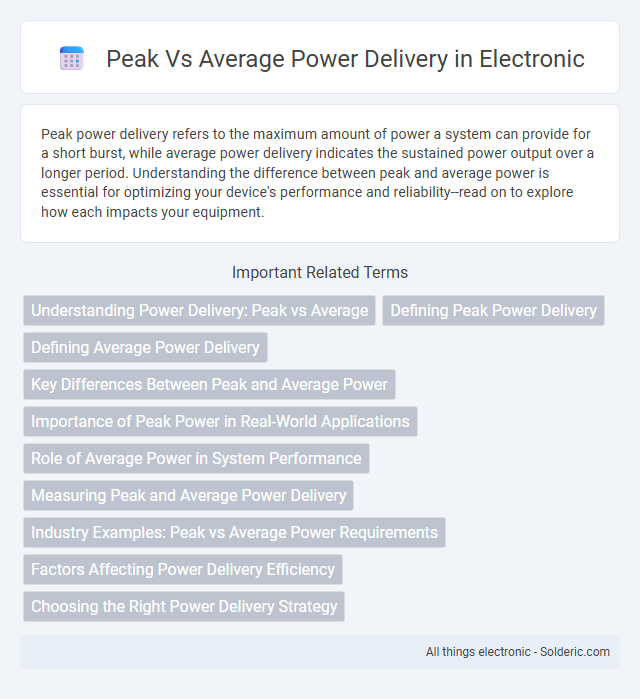Peak power delivery refers to the maximum amount of power a system can provide for a short burst, while average power delivery indicates the sustained power output over a longer period. Understanding the difference between peak and average power is essential for optimizing your device's performance and reliability--read on to explore how each impacts your equipment.
Comparison Table
| Aspect | Peak Power Delivery | Average Power Delivery |
|---|---|---|
| Definition | Maximum power output at a given moment | Power output averaged over time |
| Measurement | Instantaneous watts (W) | Watts over defined period (W) |
| Use Case | Short bursts, high-demand tasks | Continuous performance, sustained operation |
| Impact on System | Stress on components due to spikes | Thermal stability during steady use |
| Examples | CPU turbo boost, audio amplifier peaks | Power rating of PSU, average streamed power |
| Importance in Design | Ensuring capability for demand spikes | Ensuring reliability and thermal management |
Understanding Power Delivery: Peak vs Average
Peak power delivery represents the maximum instantaneous power a system can provide, crucial for handling short bursts of high demand. Average power delivery measures the sustained power output over a period, reflecting the system's long-term performance capabilities. Distinguishing between these metrics is essential for optimizing energy efficiency and ensuring reliability in power systems design.
Defining Peak Power Delivery
Peak power delivery represents the maximum amount of power a device can output or handle for a very short period without damage or performance loss. It differs significantly from average power, which measures the sustained power over time during typical operation. Understanding peak power delivery helps you evaluate the device's capability to handle sudden surges or high-demand tasks efficiently.
Defining Average Power Delivery
Average power delivery refers to the consistent amount of energy transferred over a given period, measured in watts, reflecting the typical performance of an electrical device. It contrasts with peak power, which indicates the maximum instantaneous power output during short bursts. Understanding your system's average power delivery helps ensure reliable and efficient operation without overloading components.
Key Differences Between Peak and Average Power
Peak power represents the maximum instantaneous power output a system can deliver, measured over a very short period, often critical for handling sudden spikes or surges in demand. Average power reflects the continuous power output sustained over a longer duration, providing a more realistic measure of typical energy usage or performance in applications like electronics, engines, and renewable energy systems. Understanding the key differences between peak and average power is essential for designing components that balance performance, efficiency, and thermal management.
Importance of Peak Power in Real-World Applications
Peak power delivery is critical in real-world applications because it determines the maximum instantaneous power a device can handle, such as in electric vehicles during acceleration or audio amplifiers reproducing dynamic sounds. Unlike average power, which represents the sustained output over time, peak power addresses transient demands that prevent performance bottlenecks and ensure reliability. Understanding peak power ratings helps engineers design systems that maintain optimal function under sudden high loads, enhancing durability and user experience.
Role of Average Power in System Performance
Average power plays a crucial role in system performance by determining the sustained energy availability for continuous operation, affecting thermal management and component longevity. Unlike peak power, which reflects short bursts of maximum output, average power dictates the efficiency and reliability of devices such as battery-operated systems and electric motors. Optimizing average power ensures balanced performance, preventing overheating and enhancing overall system durability.
Measuring Peak and Average Power Delivery
Measuring peak and average power delivery involves capturing the highest instantaneous power output and the typical power over a specific period, respectively. Specialized instruments like oscilloscopes and power analyzers quantify peak power by detecting voltage and current spikes, while average power is calculated using continuous data sampling or RMS values. Understanding both metrics helps you assess system performance, efficiency, and reliability in applications ranging from electrical grids to audio amplifiers.
Industry Examples: Peak vs Average Power Requirements
In electric vehicle manufacturing, peak power delivery is critical during acceleration bursts, while average power sustains longer trips efficiently. Data centers prioritize high average power to maintain uninterrupted operations, but peak power capacity ensures resilience during sudden processing surges. Your system design should balance peak versus average power needs to optimize performance and cost in industrial applications.
Factors Affecting Power Delivery Efficiency
Power delivery efficiency is influenced by factors such as thermal management, component quality, and transient response capabilities. Peak power demands often cause voltage drops and increased heat dissipation, reducing efficiency compared to stable average power delivery. Optimizing semiconductor materials and circuit design minimizes resistive losses and improves overall power delivery performance.
Choosing the Right Power Delivery Strategy
Choosing the right power delivery strategy depends on whether peak or average power requirements dominate your application. Peak power delivery accommodates sudden, high-demand bursts essential for performance spikes, while average power delivery ensures sustained, continuous energy supply critical for efficiency and device longevity. Understanding your system's power profile helps you optimize energy management, balancing reliability and cost-effectiveness.
peak vs average power delivery Infographic

 solderic.com
solderic.com